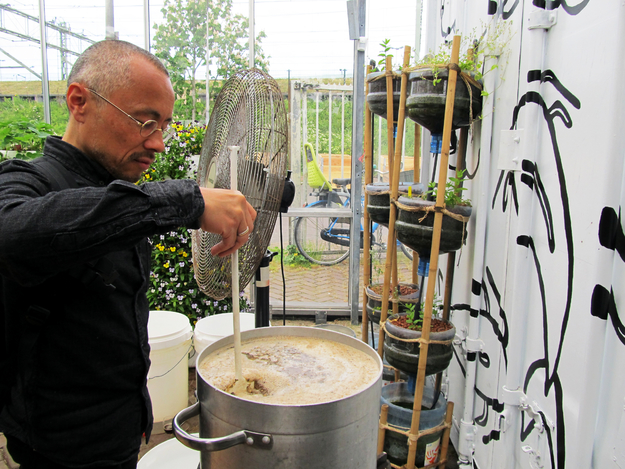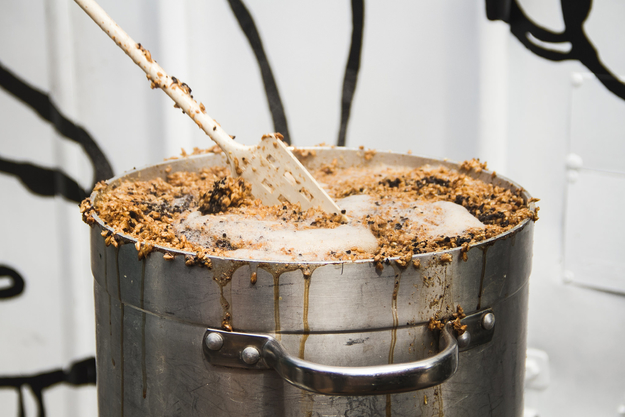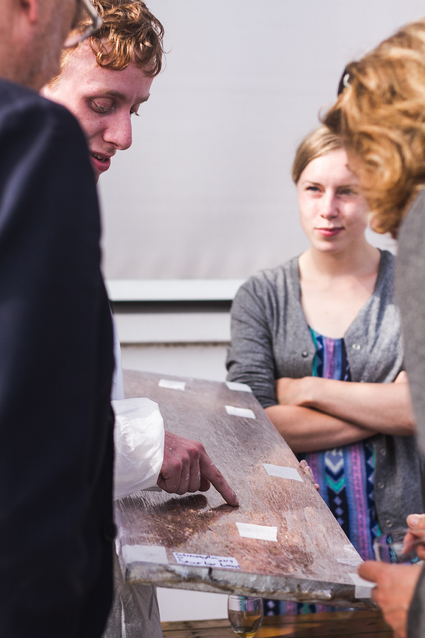From waste to insulation
Why throw away the spent grain from brewing beer when it could become food (substrate) for our mycelium based insulation panels?
This is the thought that brought us to this moment: Adapting a beer recipe & altering the standard process of beer brewing in order for the waste (grain) to be re-used in combination with mycelium to grow our new material for insulating the black barn, here at Mediamatic.
So during the Beer brewing workshop, we tried it out!
Alternative Recipes
Simon divided the workshop into three teams. One chose to brew a Belgium Triple, another a Blonde, and we (myco-team) chose to brew a stout.
With the stout recipe, we continued with the brewing, but kept the grain in during the cooking phase, where as the other two teams followed the usual brewing method, where the grains are removed before cooking it at 100 centigrade for one hour.
Cooking at 100ºc with the grains still in the wort, may produce more tannins (polyphenols). They tend to manifest themselves as a stringent or bitter flavor in the finished beer. Overcoming this is one of our many challenges: How to lower the acidity of the beer grain while maintaining a good beer taste, regardless of our myco-alterations?
This diagram explains how we have altered the brewing method:

Stout Beer ingredients:
::Grain::
2 kg Pale mout halcyon (5EBC)
168 g Geroosterde gerst (1200EBC)
80 g AMROMA (Smoked barley)
::Hops:: (total 37 grams)
17 g Amarillo 10 Alpha
10 g Cascade
10 g Centanial
One packet of yeast.
15 litres of water
Milling
For an effective Mash, the grain must be broken apart (milling). This involves smashing the grain for direct access to the starch inside the husks. This starch is later converted (during mashing) into sugars, which in turn are converted into ethanol (alcohol) & Co2. Milling - Milling the grain at Brew Your Own 6-pack workshop with Simon Buijs 24th May 2015

But don't smash it completely as this will be impossible to separate later, this is why the grain is partially milled, enough to get the starch, but not so vigorously that you end up with flour!
Mashing
Here, the enzymes in the malt break down the starch in the grain into sugars, (typically maltose) creating a malty liquid called 'wort'. This is achieved by heating the mixture and pausing at certain temperatures (varies from recipe to recipe).
For this stout recipe we did the following:
Heat the water up to 64ºc.
Then add the milled grains, hold temperature here for 30 mins.

Raise to 68ºc and hold for 15 mins.
Finally raise to 72ºc and hold here for 15 mins.

:: At this stage you normally separate the grains from the wort (Lautering)::
But we are not. Instead, we leave the grains in the wort and move to the next step:
Cooking
Raise the temperature to 100ºc and hold for 1 hour. This is pasteurizing the grain, so we can grow mycelium on it later.


At the beginning of cooking you can add some hops, this will bring bitter tastes into the resulting beer. Hops! - Cascade , Centanial and Amarillo! Adding hops to the stout beer wort.
At the end you can also add some more hops. When we say end, we really mean it. Turn the heat off, wait for 10 mins and then add the final hops, and leave it also for just 10 mins before separating the grain & hops from the wort. Adding hops at the end brings sweet and fruity flavors to the beer.

Adding the hops. We used 10 g Cascade, 10 g Centanial and 17 g Amarillo.

You can perform a starch test with iodine solution. Just drip some of your wort onto a surface. Then splash some iodine solution onto it. If it remains purple, there is still starch present. If it turns a brown- yellowish colour, then the starch has been converted into sugars.
After cooking is complete, and the final hops have been added, we separate the grains from the wort. In the beer brewing universe, this is called Lautering. Filtering the Wort - Brewing a stout beer Simeon and Lex filter the grain and sparge it.

Lautering
A bucket with holes in the bottom was placed inside a larger bucket, which had only a tap. The whole brewing mixture (grains in wort) was then poured into the first bucket as it sits inside the second bucket. The wort drips through and the grain remain in the first bucket.
We then opened the tap and poured the gain-less wort into a third bucket, ready for fermentation, by adding the yeast. But first you must wait for the wort to cool down before adding yeast! 20 centigrade to be exact.
Chalk to Grain for pH - Raising the pH of the beer grain from 5 to 6 pH by adding chalk.

The 'waste material' from the beer brewing process: the spent grain (and in this experiment the Hops). The hot, wet grain is also acidic, not at all ideal conditions for happy mycelium growth.


With a 5 pH reading we add some chalk to balance it toward 6 pH.
While the grain cools down, we prepared the panel in which we shall inoculate the grains.

As the grains continue to cool down we spread it out.
Once the grain has cooled below 20 centigrade, we can begin inoculating.
The crucial moment has arrived!
Inoculation
With 100 g of Schizophyllum grain spawn, we inoculate the panel. Some mixing is needed. Schizophyllum Grain Spawn - This is used to inoculate our panels. We also use Oyster Mushroom spawn.
Inoculating Spent Beer Grain - Inoculation of beer grain with Schizophyllum spawn



Once the beer grains have been mixed with the mycelium spawn, we then wrap it up with cling film ( a temporary solution) and make holes, covered with breathing tape as the mycelium will need some oxygen to grow. Also mycelium produce a lot of C02 and that also needs to escape.
The inoculated panel is then taken to the incubation room and left there to grow in the dark at 28-30 centigrade.
First Myco-beer grain panel - Simeon explains: stout beer grain & schitzophillum mycelium.


And now we wait!
The days hard work brewing is rounded off with a tasting session of more craft beers in the sun!

The following weeks shall reveal the results.


